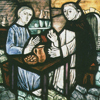


Anniversary
![]() Dominican
Dominican
Tradition
![]() Dominican
Dominican
Spirituality
![]() Dominican
Dominican
History
![]() Becoming
Becoming
Dominican
![]() OP
Sources Edgewood College
OP
Sources Edgewood College
800th
Anniversary
Within a few days, on the Feast of the Epiphany, we close the Jubilee year thanking the Lord for the 800 years of life for our Nuns of the Order. It has been a year of great blessings touching not only the whole Order, but indeed the broader Church as well. I have been delighted to see so many creative initiatives undertaken by our nuns. Books have been published, hymns have been written, new research into their early foundations has been undertaken, and their contemplative prayer has been and is being renewed. Indeed, the whole Order has come to a better appreciation that the nuns are at the heart of the Order and that the foundation of our preaching is nothing less than the profound contemplation of our faith. I believe that the renewal of the life of our nuns is directly linked to the renewal of the whole Order. While this Jubilee year comes to an end, we now begin to undertake a novena of years, culminating in the Jubilee of 2016, 800 years of papal confirmation of the Order of Preachers. At our recent General Chapter in Bogotá, the capitulars requested that we use the time between these two jubilee years (2006-2016) as a time to enter into a serious renewal of our life and mission as preachers. (General Chapter of Bogotá #51) Therefore, I wish to invite each entity of the Order as well as each community and individual to begin the long process of renewal through reflection, decisions and actions taken relating to our whole way of life as preachers of the Gospel. In
order to provide a focus for this next year, I am proposing
that we begin to renew our preaching way of life through
re-discovering the Rosary as a means of contemplation
and an instrument of prophetic preaching. In
many ways the Rosary, as a uniquely Dominican contribution
to the life of the Church, has slipped from our grasp. And,
yet at the same time, the Rosary remains very much
alive among us. In this letter I would like to
offer a simple meditation on the Rosary from the viewpoints
of memory, theological reflection and popular religiosity. Permit me to bring to mind a few of my own memories, which I hope will elicit some of your own. Memories are important in shaping our identity, putting flesh and blood onto our ideas, and enabling us to re-live and re-interpret pivotal moments in our life. My first recollection of the Rosary goes back to my early years at Champagnat School of the Marist Brothers in Buenos Aires with the first Rosary that I held in my hands. The brothers instilled in us a real love of Mary as a mother who unconditionally loves and intercedes for her beloved sons and daughters, the Mary of St. John’s Gospel. Of course, we had the month of Mary with processions, rosary, and litanies. Even as a young person, I carried a “decade” in my pocket. The repetition of the “Our Father”, “Hail Mary” and “Glory be” allowed this prayer to take a deep root within my own life. To this day, I especially like to pray this prayer while walking. It accompanies me through different landscapes, whether on the road or in town. It is the “wandering contemplation” of which fr. Vincent de Couesnongle spoke. It begins to mark the rhythm of my footsteps, allowing me to have a hold on the world that is constantly in flux. It allows me to give soul, life and heart to the city or place through which I am only passing; to meetings that await me with all their joys and hopes, lights and shadows. Recently, during one of our retreat days, the General Council reflected on the mystery of death. One of the friars described how dying brothers almost always asked for their Rosary, even if it was only to hold it. I remember seeing the film “Batismo de Sangue” (Baptism of Blood), the story of our Brazilian brothers being tortured back in the 70’s during the dictatorship of Medici. Bro. Tito de Alencar, as he was being dragged out of the convent, shouts for a brother to go for his Rosary. What did it mean to him at that hour of terror? What are your memories regarding the Rosary? What might these mean for you? For me? What might our theological study and reflection have to tell us about them? 2. Theological Reflection I believe these memories speak to us of the nearness of God. The mystery of the Incarnation is not only about the birth of the Lord in millennia past, but about the incarnation of grace, or the birth of God, in our own daily lives. Jesus lives and His Spirit continues to heal, teach, forgive, comfort and challenge us. This is not an empty abstraction, but rather is made visible in and through the images associated with the mysteries of the Rosary. Awareness of the incarnation increases as one allows these images to intersect with the concerns of our own daily life. Thus, the Rosary is profoundly incarnational, biblical, Christ-centered, and contemporary. Most obviously, the Rosary is Marian. Let us be clear as to what this means. In Mary, divinity becomes united with humanity; the creature becomes one with the Creator. In Mary we recognize both our identity and our destiny. We see this holy communion of God-with-us and God-within-us. We realize that our God is God-for-us—redeemer and savior, sanctifier and glorifier. Indeed, Mary is a central figure in our life of faith. While we can think of her as Daughter of the Father, Mother of the Son, and Spouse of the Spirit, we ought also to see her as a believer in the valley of darkness, and one who hopes when confronted by a situation of despair. She can be seen as a protector of pregnant women who give birth in poverty, a patroness of those who migrate to foreign lands in order to survive, and as one who keeps vigil when her child is arrested, tortured and killed. And yet, through all this we see the triumph of her faith, hope and love. Pope John Paul II invited us to contemplate the face of Christ through the eyes of Mary. What might this mean to us? As Master of the Order, I am a missionary who strengthens my brothers and sisters scattered throughout the world. I hear their stories and see their reality. I remember the faces of Christian families badly wounded at Bahawalpure (Pakistan 2001), the neighbors of our sisters in the poorest barrios of Kinshasa (Congo), the children following us in Cameroon, in the Civil War Square in Campodos (Tibu) ,Colombia, families fishing from the canoes off Gizo in the Solomon Islands or in the Urumanba River in the Peruvian Amazon. These images accompany the mysteries and so the Rosary becomes my intercession, along with Mary’s, in placing the wounded at the feet of Jesus. Our world is one that seems to be constantly torn apart by war. Uppermost in my mind is war-torn Iraq, and of course not far behind is the continual bloodshed between Israeli’s and Palestinians. The 20th century was a century of wars and devastation across the planet. In the worst of these moments, people turned to the Rosary praying for peace. Indeed, was that not the focus of the Fatima devotions for the conversion of Russia and was not Mary invoked as the Queen of Peace? At the same time, let us not minimize those cold wars that can go on within families, communities, and within our own hearts and souls. Cannot the Rosary bring us to peace? This year we also celebrate the 50th anniversary of fr. Dominique Pire, our Belgian brother, who won the Nobel Peace prize for establishing islands of peace. Perhaps his inspiration for this project flowed from his meditations while praying his Rosary for peace. The words of the prayers accompanying my meditations speak of the kingdom of God, of daily bread, of liberation from evil, of the fruit of the womb, of sinners and of the hour of death. The kingdom of God is justice and peace. The will of God does not coincide with those trampled underfoot. Bread is to be shared. Forgiveness is to be given. The blessed fruit of the womb of women is sacred. Yes, the Rosary—words of Scripture and our lived meditation—makes it a prophetic prayer as well as a contemplative prayer; a prayer that both announces and denounces, a prayer that consoles and transforms. The words that give praise to the Trinity invite us to live in community, without subordination, where each person is totally open and available to the Other. Yes, “God’s will” will be done and so we never despair. Our preaching is hope-filled because “…that which has existed since the beginning, that we have heard with our ears, and we have seen with our own eyes; that we have watched and touched with our hands: the Word who is life—this is our subject.” (1 John 1) Living in the company of Jesus, as Mary did, we become the disciple and the apostle that the world needs and God desires. 3. Popular Religious Practice After Vatican II, we tended to downplay the importance of “popular religiosity.” Correctly, we emphasized biblical study and greater liturgical participation. In doing this, we also minimized those popular expressions that allowed greater religious sentiment to be expressed; e.g. benediction, processions, pilgrimages to Shrines, Rosary devotions, etc. Now, after forty (40) years of experience, we see that people both old and young need these expressions in order “to fan into a flame the gift that God gave you.” (2 Tim. 1:6) Such popular religiosity still asserts itself at the great Marian Shrines in every part of the world. This year we celebrate 150 years of Lourdes (France) and 90 years of Fatima (Portugal), just two Shrines that attract literally millions of people every year. One can also think of Guadalupe (Mexico), Czestochowa (Poland), Knock (Ireland), Chiquinquira (Colombia), Coromoto (Venezuela), Lujan (Argentina), Manaoja (Philippines), and so on. Almost every country of the world has its national shrine to Our Lady that gathers the faithful from far and wide into a maternal embrace. We still see St. Christopher medals in cars as well as rosaries hanging from rear view mirrors, small altars in homes, or statues in gardens. There are the rituals of ashes at the beginning of Lent and palms at the beginning of Holy Week that inform us as to the desires and religious sentiments of the people. These are rituals that inject a certain order and stability, a certain rhythm and incarnational dimension into the life of ordinary people, enabling them to experience more intense religious moments. Can we Dominicans recover this popular religiosity in terms of something that is peculiarly ours: the Rosary? I have come to see the Rosary as indeed a beloved universal prayer. Whether in Italy or The Ukraine, Mexico or the United States, the Philippines or Vietnam, Kenya or Nigeria, the Rosary is found, prayed and loved. I believe one reason for this is because it is a tangible reality as well as a prayer. It is something almost every Catholic owns. It is given as a gift. It is a ritual whether said alone or together. It is something we can touch, hold, and even grasp at difficult moments of our life; it is like grasping the hand of Mary herself. The Rosary is placed in our hands both at the “hour of our death” and afterwards when we are buried. The prayers of the Rosary are summaries of our faith. Learning these prayers is like learning to talk; it is the beginning of our prayer life; and yes, it is also the end of our life of prayer—“your will be done” “now and at the hour of our death.” We are given a Rosary in our youth, we receive a Rosary when we take the habit, and a Rosary is at our side when we are buried. Conclusion I have shared with you some of my reflections, I hope both simple and profound, perhaps more a meditation and heartfelt reflections than anything else. At the General Chapter of Bogotá, it was my privilege to appoint fr. Louis-Marie Ariño-Durand of the Province of Toulouse as the new Promoter of the Rosary. He has developed and is developing an extensive web-site which can be of service to you during this next year. In turn, I am asking you to help him in its development by responding to his requests. Together we can build a web-site that can be beneficial to the whole Church. As we begin this novena of years in preparation for the anniversary celebration of 2016, can we use this next year, Epiphany 2008-Epiphany 2009 as a year to rediscover the Rosary in our personal life, our community life and in the renewal of our preaching which is both contemplative and prophetic? Can we help shape the popular religiosity of our people through developing anew Rosary novenas, missions, processions or shrines? Can we contemplate our Master through the eyes of the perfect disciple? Can we contemplate the Son through the eyes of the Mother? Can we contemplate our world as one profoundly in need of transformation by the Gospel? Can we come to live and preach passionately with the creativity of God the Father and of Mary the mother of the beloved Son? I am grateful to have had this opportunity to share with you my own reflections. In the coming months, the General Council will outline the different steps and themes for the next several years of this on-going renewal of our life and mission. I would ask the Provincials and Vicars-General, Prioresses, and Presidents of our Lay Fraternities to see that this letter is circulated among their members. Throughout this New Year, know that you will be frequently remembered in my thoughts and prayers. In turn, I ask for yours. Brothers and Sisters, let us walk this road of renewal together. Let us set out having the confidence that Dominic had in Mary, the Mother of God. Your brother in Dominic,
fr. Carlos A. Azpiroz Costa, O.P.
Prot.: 50/07/1404 – Lettere all’Ordine |
Download Carlos' reflection on the rosary in a Word document here.
|
subscribe to
DomLife.org and receive a free email update every two weeks. unsubscribe |
 Dear
Brothers and Sisters,
Dear
Brothers and Sisters,